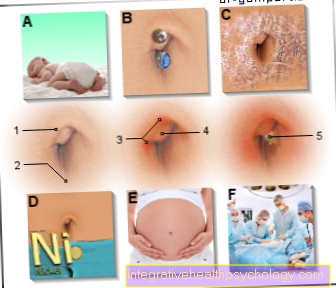Diastasis recti
Definition - what is diastasis recti?
Diastasis recti is a weakness of the abdominal wall that is acquired in most cases. The straight abdominal muscles diverge (Mm. recti abdomini). These abdominal muscles are connected by a layer of connective tissue called the linea alba. As the muscles move apart, the linea alba is also widened and a palpable gap is created.
Diastasis recti often result from increased pressure in the abdomen, e.g. during pregnancy or if you are very overweight.

In infants, diastasis recti is physiological because the distance between the straight abdominal muscles is greater than in adults. When sitting down, there may be a bulge in the area of the abdomen. This is harmless and usually goes away when the child begins to stand.
causes
-
Pregnancy: increased pressure in the abdomen
-
Obesity: The abdominal wall is stretched and the abdominal muscles move apart more easily
-
physiological diastasis recti in newborns
After a pregnancy
During pregnancy, the growth of the abdomen causes the straight abdominal muscles to diverge in order to create enough space for the child. Furthermore, pregnancy hormones such as the relaxin to make the tissue soft. So diastasis recti is normal during and after pregnancy.
Also read: When does the belly grow during pregnancy?
After pregnancy, the abdomen regresses and the abdominal muscles regain tension. Here it is important to carry out targeted exercises to strengthen the abdominal muscles slowly and in a controlled manner by a midwife or a physiotherapist.
Read more on the subject at: Postnatal exercise
Diastasis recti in the baby
Diastasis recti in babies is a physiological condition in the first year of life. This is because the straight abdominal muscles in the infant are still relatively far apart. The abdomen may bulge slightly when sitting down. This is not a cause for concern. As soon as the children start to stand and walk, the diastasis recti closes on its own in most cases.
diagnosis
To diagnose a diastasis recti, a doctor will first ask in a conversation whether several pregnancies have already existed.
The diastasis recti can be felt relatively easily by the doctor above the navel. To do this, the patient lies on his back and lifts his head slightly. The abdominal muscles are tense and the gap can be felt. When sitting up or coughing, a bulging of the stomach can usually be seen at this point.
It is also possible to visualize the diastasis rectus in an ultrasound examination. In the vast majority of cases, however, this is not necessary.
Can you feel a diastasis recti yourself?
Like the doctor, you can feel the diastasis recti in yourself. To do this, lie on your back, lift your head slightly and tense your stomach. Now you can feel a gap in the abdominal muscles just above the navel.
In pregnant women, however, the gap can only be felt after the birth.
These are the symptoms you can tell if you have diastasis recti
Usually, diastasis recti does not cause any problems. It can be felt and when the abdomen is tensed it can lead to a bulging in this area. However, this is completely harmless.
In late pregnancy, diastasis recti can cause symptoms such as Lower back or hip pain. This is due to an imbalance between the postural muscles of the back and the abdominal muscle culture.
Read more on the subject at: Lower back pain
Pain from diastasis recti
Especially pregnant women in the last trimester of pregnancy are more likely to experience pain in the lower back and hips due to the diastasis rectus. The pain occurs mainly during exercise. The pain is caused by an imbalance between the back and abdominal muscles. The diastasis rectus weakens the abdominal muscles and the muscles of the back are more stressed. This can lead to pain.
Read more on the subject at: Back pain in pregnancy and Hip pain in pregnancy
Bowel problems
With a diastasis rectus, there is an increased risk of abdominal wall hernias or umbilical hernias, in which parts of the intestine turn outward through the abdominal wall.
There is a risk that the intestinal parts get trapped and lead to severe pain and gastrointestinal complaints such as nausea and vomiting. If treatment is not carried out quickly, the blocked blood supply can cause the prolapsed part of the intestine to die.
Also read: Pain after an umbilical hernia
The therapy of choice is, if presented early, an operative relocation of the hernial sac back into the abdominal cavity and a closure of the fracture site with an inlay of a plastic mesh.
Also read: Umbilical hernia surgery
treatment
The following methods are available to treat diastasis recti:
-
Abs workout
-
Postnatal exercise after pregnancy
-
Weight loss when overweight
-
Wearing a special corset
-
in rare cases surgical closure
These exercises can help
The most important exercises are aimed at strengthening the abdominal muscles. It is important to start slowly after pregnancy. Examples of exercises are shown below.
-
Controlled breathing: The abdominal muscles are also auxiliary breathing muscles. Therefore, targeted breathing can also strengthen this. To do this, lie on your back, put your legs up and breathe in through your nose and out through your mouth. At the end of the exhalation, the navel is deliberately pulled towards the spine.
-
The exercise described above is performed. The head is raised slightly.
-
The first exercise is carried out again. In addition, both hands are placed on one thigh and looked in this direction. This mainly strengthens the oblique abdominal muscles.
-
Quadruped: Stand on quadruped with your back straight, your hands under your shoulders and your knees under your hips. Now the navel is pulled back to the back, held there briefly and relaxed again.
How can you tape a diastasis recti?
Taping a diastasis recti can aid healing. Nevertheless, training with strengthening exercises is necessary.
Attaching a tape promotes blood circulation and gently stimulates the abdominal muscles. It should always be applied by a doctor or physiotherapist experienced in taping.
Read more on the subject at: Kinesio tape
Which doctor treats diastasis recti?
In principle, no treatment for diastasis recti is necessary. It is sufficient to discuss exercises to strengthen the abdominal muscles with a physiotherapist or after pregnancy with a midwife and to carry them out regularly.
If an occlusion is desired or medically necessary, a plastic surgeon can perform this operation.
When do you need an operation?
Usually no surgery is necessary. The diastasis rectus is more likely to be perceived as cosmetically annoying and therefore an operation, if it is not medically necessary, is not covered by the statutory health insurance.
However, if additional umbilical hernias occur, which harbor the risk of entrapment of parts of the intestine, an operation may be necessary. For this, a surgeon fixes the abdominal muscles with a suture. If necessary, a plastic mesh is also used.
After the operation, it is necessary to wear a waist belt for about 6 weeks. Heavy lifting and sports are prohibited during this time.
forecast
A regression is quite possible, especially with targeted training. However, it can take some time and the exercises should be done regularly and conscientiously. Very small diastases of the rectus can also heal spontaneously.
Surgery can also cure diastasis recti. However, the risk of recurrence, i.e. renewed diastasis rectus, is relatively high even after an operation.
Duration of diastasis recti after pregnancy
Many pregnant women suffer from diastasis recti at the end of pregnancy and after childbirth, as the abdominal muscles in particular have been stressed by the strong growth of the abdomen. Small diastases of the rectus heal within weeks to months. The healing process can take up to a year.
Regular postnatal training and exercises for the abdominal muscles under the guidance of a midwife or a physiotherapist can help speed up this process. It is important not to lift heavily or to do any exercises for the abdominal muscles, e.g. Do sit-ups, as this can make a diastasis rectus worse.
When can I exercise again after a diastasis rectus?
When exactly “normal” training can be resumed after a diastasis rectus, it cannot be said in general terms. This depends on how large the diastasis recti is and how the regression develops. After pregnancy, it is assumed that the tissue is still very soft due to hormones in the first year after delivery. Careful postnatal exercises should be carried out here, but not heavy abdominal muscle training.
If there is a diastasis rectus, the training should always be discussed individually with a doctor, midwife or physiotherapist, as they can best assess what is best in the individual case.
Can I jog with a diastasis recti?
If you have large diastases, you should avoid jogging for the time being. If you have diastasis rectus after pregnancy, experts recommend that you do not go jogging for the first year after the birth. First of all, the abdominal muscles should be strengthened in order to support the healing of the diastasis rectus and not to overuse the back and pelvic muscles.
Experts such as doctors, midwives or physiotherapists should make individual statements about when to start jogging again. There is no general statement for this.
How can I prevent diastasis recti?
A diastasis recti during or after pregnancy is quite normal and necessary to provide enough space for the child. The size of the diastasis recti can be influenced here. In general, well-trained abdominal muscles before pregnancy can help.
During pregnancy, care should be taken that when standing up from the supine position, you always turn on your side first. So the straight abdominal muscles are spared. Furthermore, no exercises should be performed that strain the straight abdominal muscles. Lifting shouldn't be difficult, especially in the second half of pregnancy.
You might also be interested in: Exercise during pregnancy
Why is diastasis recti common with an umbilical hernia?
As the straight abdominal muscles move apart, the connective tissue layer expands (Linea alba) also off. This layer of connective tissue represents a weak point in the abdominal wall. Through heavy lifting, it can happen that parts of the intestine in a so-called hernial sac can protrude outwards through this point.
Read more on the subject at: Symptoms of an umbilical hernia
This is usually harmless. However, the prolapsed intestinal loops can become trapped and their blood supply can be cut off. This leads to severe abdominal pain and if no treatment is given, the intestinal parts can die off. Umbilical hernias are usually closed surgically.
Recommendations from the editorial team
- Abdominal muscle training during pregnancy
- Exercise during pregnancy
- Postnatal exercise
- Umbilical hernia
- Back pain in pregnancy





























